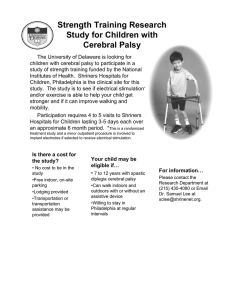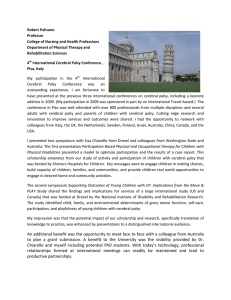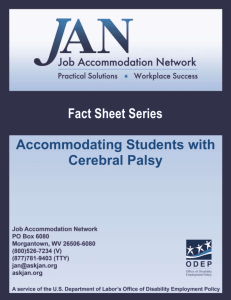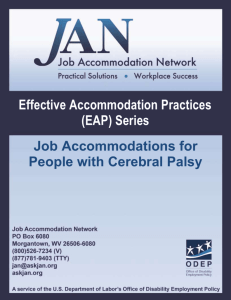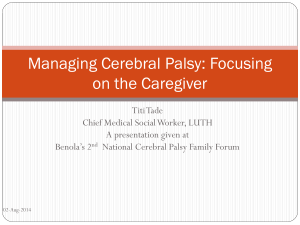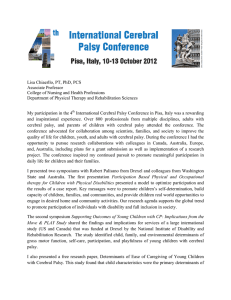Joining in: investigating use of eye gaze
advertisement
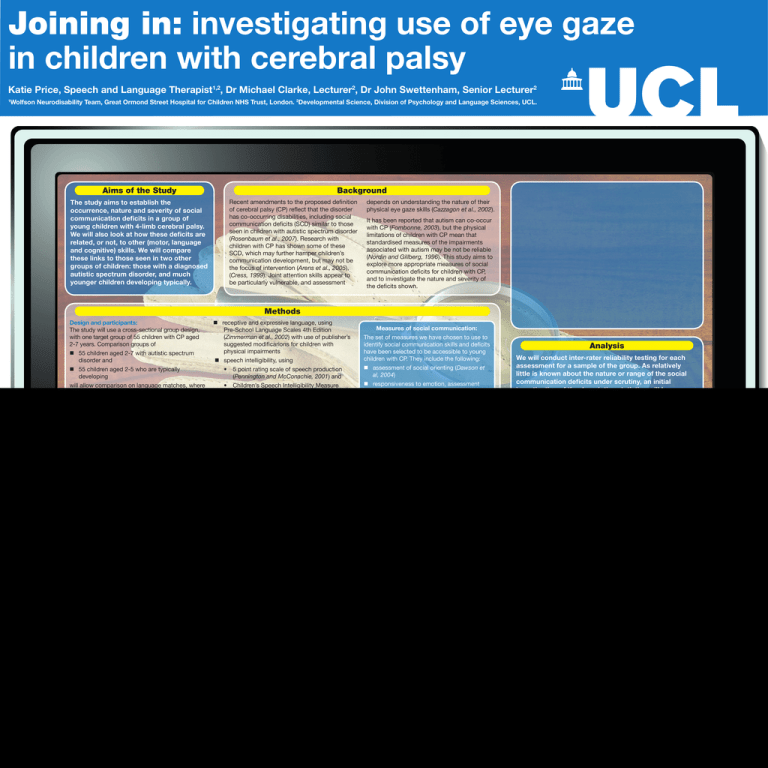
Joining in: investigating use of eye gaze in children with cerebral palsy Katie Price, Speech and Language Therapist1,2, Dr Michael Clarke, Lecturer2, Dr John Swettenham, Senior Lecturer2 1 Wolfson Neurodisability Team, Great Ormond Street Hospital for Children NHS Trust, London. 2Developmental Science, Division of Psychology and Language Sciences, UCL. Background Aims of the Study The study aims to establish the occurrence, nature and severity of social communication deficits in a group of young children with 4-limb cerebral palsy. We will also look at how these deficits are related, or not, to other (motor, language and cognitive) skills. We will compare these links to those seen in two other groups of children: those with a diagnosed autistic spectrum disorder, and much younger children developing typically. Recent amendments to the proposed definition of cerebral palsy (CP) reflect that the disorder has co-occurring disabilities, including social communication deficits (SCD) similar to those seen in children with autistic spectrum disorder (Rosenbaum et al., 2007). Research with children with CP has shown some of these SCD, which may further hamper children’s communication development, but may not be the focus of intervention (Arens et al., 2005), (Cress, 1999). Joint attention skills appear to be particularly vulnerable, and assessment depends on understanding the nature of their physical eye gaze skills (Cazzagon et al., 2002). It has been reported that autism can co-occur with CP (Fombonne, 2003), but the physical limitations of children with CP mean that standardised measures of the impairments associated with autism may be not be reliable (Nordin and Gillberg, 1996). This study aims to explore more appropriate measures of social communication deficits for children with CP, and to investigate the nature and severity of the deficits shown. Methods Design and participants: The study will use a cross-sectional group design, with one target group of 55 children with CP aged 2-7 years. Comparison groups of 55 children aged 2-7 with autistic spectrum disorder and receptive and expressive language, using Pre-School Language Scales 4th Edition (Zimmerman et al., 2002) with use of publisher’s suggested modificarions for children with physical impairments speech intelligibility, using Measures of social communication: The set of measures we have chosen to use to identify social communication skills and deficits have been selected to be accessible to young children with CP. They include the following: 55 children aged 2-5 who are typically developing • 5 point rating scale of speech production (Pennington and McConachie, 2001) and assessment of social orienting (Dawson et al, 2004) will allow comparison on language matches, where normative data is not available for measures used. • Children’s Speech Intelligibility Measure (Willcox and Morris, 1999) responsiveness to emotion, assessment of joint attention, and symbolic comprehension Exclusion criteria will comprise severe/profound hearing loss severe uncorrected visual acuity impairments uncontrolled seizure disorder language understanding below 18 month level Participating families will be approached via collaborators at Great Ormond Street Hospital, and through Nursery Classes in Special Schools in London. Background measures: Children will attend for assessment of functional motor ability, using the Gross Motor Function Classification System (Rosenbaum et al., 2008), and the Manual Ability Classification System (Eliasson et al., 2006) non-verbal cognition, using sub-tests from the British Ability Scales (Elliot, 1996). There is no clearly suitable published assessment for cognitive assessment for children with CP, and a full range cognitive skills may not be accessible, but this will offer some information for this population. Pre-requisite measures: As our target measures (see below) involve use of eye gaze for joint attention, we will first investigate abilities with physical control and visual attention to respond to non-social stimuli as follows: non-social orienting: fixing gaze on an object as it appears in the field of view 2-place gaze transfer; following and anticipating with eye gaze as objects are related (for example, as a ball goes into a box) (Chiat and Roy, 2008). This is a three-part assessment (Very Early Processing Skills) • developed for use with children with speech and language impairment, but with responses possible through eyegaze alone • using toys to elicit responses in each category • deriving numeric scores for each set of skills, and in total other social/emotional engagement available despite physical limitations, to include engaged facial expression, enjoyment or interest in task, gaze coordinated with facial expression, gesture or vocalisation Analysis We will conduct inter-rater reliability testing for each assessment for a sample of the group. As relatively little is known about the nature or range of the social communication deficits under scrutiny, an initial investigation of the descriptive statistics will be informative. Further group comparisons and regression models will then be undertaken. ARENS, K., CRESS, C. J. & MARVIN, C. A. 2005. Gaze-shift patterns in young children with developmental disabilities who are at risk for being nonspeaking. Education and Training in Developmental Disabilities, 40, 158170. CAZZAGON, M., OLIMPI, I., CORDARO, C., ALDE, G. G. & PIERRO, M. M. 2002. Visual and motor control disorders in children with cerebral palsy: a proposed guide to evaluate the oculomotor system. Europa Medicophysica, 38, 219-235. CHIAT, S. & ROY, P. 2008. Early phonological and sociocognitive skills as predictors of later language and social communication outcomes. Journal of Child Psychology and Psychiatry, 49, 635-645. CRESS, C. J., SHAPLEY, K., LINKE, M., HAVELKA, S., DIETRICH, C., AND ELLIOTT, J 1999. Intentional communication patterns in young children with physical disabilities. American Speech and Hearing Association Conference. ELIASSON, A., KRUMLINDESUNDHOLM, L., ROSBLAD, B., BECKUNG, E., ARNER, M., OHRVALL, A. & ROSENBAUM, P. 2006. The Manual Ability Classification System (MACS) for children with cerebral palsy: scale development and evidence of validity and reliability. Developmental Medicine & Child Neurology, 48, 549-554. FOMBONNE, E. 2003. Epidemiological Surveys of Autism and Other Pervasive Developmental Disorders: An Update. Journal of Autism and Developmental Disorders, 33, 365-382. NORDIN, V. & GILLBERG, C. 1996. Autism spectrum disorders in children with physical or mental disability or both. II: Screening aspects. Dev Med Child Neurol, 38, 314-24. PENNINGTON, L. & MCCONACHIE, H. 2001. Predicting patterns of interaction between children with cerebral palsy and their mothers. Developmental Medicine & Child Neurology, 43, 83-90. ROSENBAUM, P., PANETH, N., LEVITON, A., GOLDSTEIN, M., BAX, M., DAMIANO, D., DAN, B. & JACOBSSON, B. 2007. The Definition and Classification of Cerebral Palsy. Developmental Medicine & Child Neurology, 49, 1-44. ROSENBAUM, P. L., PALISANO, R. J., BARTLETT, D. J., GALUPPI, B. E. & RUSSELL, D. J. 2008. Development of the Gross Motor Function Classification System for cerebral palsy. Dev Med Child Neurol, 50, 24953. WILLCOX, K. & MORRIS, S. 1999. Children’s Speech Intelligibility Measure (CSIM). San Antonion, TX: Pearson. ZIMMERMAN, I., STEINER, V. & POND, R. 2002. Preschool Language Scale, 4th edition. , San Antonio, TX, The Psychological Corporation.
